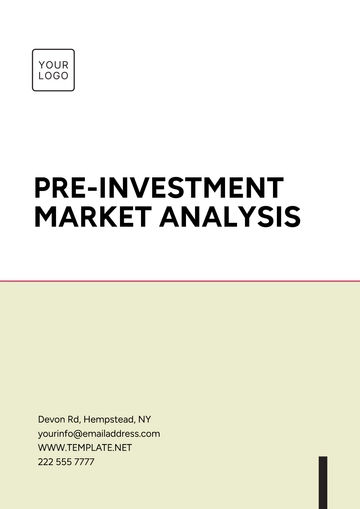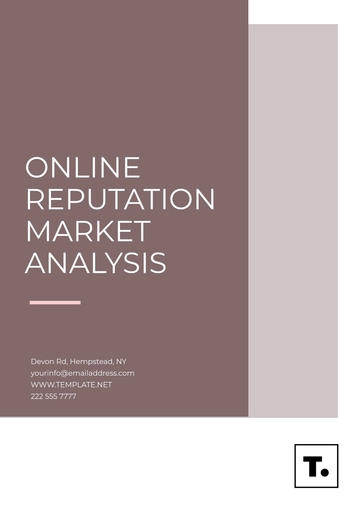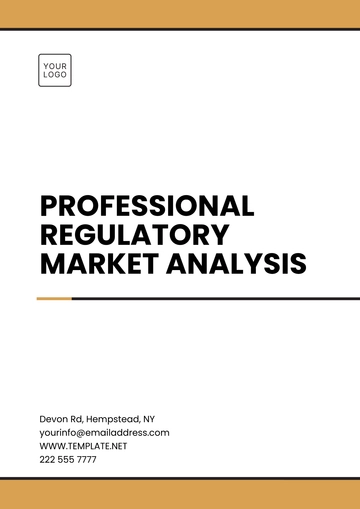Free Real Estate Rental Property Analysis

I. Introduction
This Real Estate Rental Property Analysis evaluates the potential investment opportunity presented by a multi-family property located at [Property Address]. The analysis aims to provide insights into the financial viability and potential return on investment of acquiring and renting out this property. By examining various factors such as market conditions, rental income potential, expenses, and financing options, this analysis will assist in making informed investment decisions.
II. Property Overview
A. Property Address and Description: The property at [Street Address] is situated in the heart of [Town / City], boasting a convenient location with easy access to schools, shopping centers, and public transportation. The two-story multi-family building exudes charm with its classic brick façade and well-maintained landscaping.
B. Property Type: This property represents a prime example of a multi-family residential complex, offering four distinct units suitable for families or individuals seeking comfortable living spaces.
C. Number of Units: The property comprises four spacious units, each thoughtfully designed to provide ample living space and privacy for tenants.
D. Size of Units: The units range in size from 900 to 1,100 square feet, featuring two to three bedrooms and one to two bathrooms. Each unit offers modern amenities and plenty of natural light, creating a welcoming atmosphere for residents.
E. Age and Condition: Constructed in 1995, the property has been meticulously maintained over the years, with recent updates to the interior and exterior, including new flooring, appliances, and landscaping enhancements. The building's solid construction and proactive maintenance ensure durability and longevity for years to come.
F. Amenities and Features: In addition to spacious living quarters, the property offers residents access to on-site parking, a communal outdoor area for relaxation or recreation, and convenient laundry facilities. These amenities enhance the overall appeal of the property and contribute to a high level of tenant satisfaction and retention.
G. Rent Roll:
Unit No. | Bedrooms | Bathrooms | Monthly Rent | Lease Expiry Date |
|---|---|---|---|---|
Unit 1 | 2 | 1 | $1,250 | [Date] |
Unit 2 | 2 | 1 | $1,200 | [Date] |
Unit 3 | 3 | 2 | $1,300 | [Date] |
Unit 4 | 2 | 1 | $1,275 | [Date] |
H. Current Occupancy:
Units 1 and 2 are currently occupied, with leases expiring in June and August 2024, respectively.
Unit 3 is vacant and undergoing minor renovations to attract new tenants.
Unit 4 is leased until September 2024, providing stable rental income.
I. Tenant Profile: The property attracts a diverse tenant demographic, including young professionals, families, and retirees, drawn to the neighborhood's amenities and proximity to local attractions. Tenant turnover is minimal due to the property's desirable location and well-maintained living spaces.
III. Market Analysis
A. Local Real Estate Market Overview
[Town / City]'s real estate market has experienced consistent growth in recent years, driven by a robust economy and steady population influx. The city's strategic location, favorable business climate, and quality of life amenities have attracted both residents and investors alike. Rental demand remains strong, particularly for well-maintained properties offering modern amenities and convenient access to amenities and transportation hubs.
B. Comparable Rental Properties Analysis
Property Address | Number of Units | Monthly Rent per Unit | Vacancy Rate |
|---|---|---|---|
[Street Address] | 6 | $1,275 | 4% |
[Street Address] | 8 | $1,250 | 3% |
[Street Address] | 4 | $1,300 | 5% |
The table above presents a comparison of rental properties similar to [Street Address]. These properties demonstrate a consistent demand for rental housing in the area, with varying rental rates and vacancy rates. The average monthly rent per unit among comparable properties is $1,275, with an average vacancy rate of 4%.
C. Rental Market Trends
Rental rates in [Town / City] have been steadily increasing, outpacing inflation and reflecting the city's growing popularity among renters. The demand for rental properties remains strong, fueled by factors such as job growth, population expansion, and lifestyle preferences favoring renting over homeownership. With limited new construction and a tight rental market, landlords have enjoyed stable occupancy rates and the ability to command competitive rental rates.
IV. Financial Analysis
A. Purchase Price and Financing
Metric | Value |
|---|---|
Purchase Price | $500,000 |
Down Payment | $100,000 |
Loan Amount | $400,000 |
Interest Rate | 4.5% |
Loan Term | 30 years |
The table presents the financial details related to the purchase price and financing of the property. With a purchase price of $500,000, a down payment of $100,000 is required, resulting in a loan amount of $400,000. The loan carries an interest rate of 4.5% over a 30-year term.
B. Rental Income
Unit No. | Monthly Rent |
|---|---|
Unit 1 | $1,250 |
Unit 2 | $1,200 |
Unit 3 | $1,300 |
Unit 4 | $1,275 |
This table outlines the estimated monthly rental income for each unit within the property. Unit 3 commands the highest rent at $1,300 per month, followed by Unit 1 at $1,250. The total monthly rental income for all units amounts to $5,025.
C. Operating Expenses
Expense | Amount |
|---|---|
Property Taxes | $6,000/year |
Insurance | $1,500/year |
Maintenance and Repairs | $2,500/year |
Property Management Fees | 6% of gross rental income |
Utilities | $600/month |
This table delineates the anticipated operating expenses associated with owning and managing the property. These expenses include property taxes, insurance, maintenance and repairs, property management fees, and utilities. The property management fees are calculated as 6% of the gross rental income.
D. Vacancy Rate
Metric | Value |
|---|---|
Estimated Vacancy Rate | 5% |
Potential Vacancy Loss | $251.25/month |
The table presents the estimated vacancy rate for the property, accounting for potential periods of unoccupied units. At a vacancy rate of 5%, the property stands to incur potential vacancy losses amounting to $251.25 per month based on the total monthly rental income.
E. Cash Flow Analysis
The cash flow analysis examines the net operating income (NOI) and monthly cash flow generated by the property.
Net Operating Income (NOI): Calculated by subtracting total operating expenses from gross rental income, the NOI provides a clear picture of the property's income potential before accounting for financing costs.
Monthly Cash Flow: This represents the surplus cash generated each month after deducting all expenses, including mortgage payments, from the rental income.
F. Return on Investment (ROI)
The return on investment metrics assess the profitability and efficiency of the investment.
Cash-on-Cash Return: This metric evaluates the annual pre-tax cash flow relative to the initial cash investment, expressed as a percentage. A higher cash-on-cash return indicates a more lucrative investment opportunity.
Capitalization Rate (Cap Rate): Also known as the "cap rate," this metric measures the property's expected annual return on investment based on its current market value. It helps investors compare the relative profitability of different properties.
Internal Rate of Return (IRR): The IRR represents the annualized rate of return on the investment over its holding period, considering both cash flows and the timing of those cash flows. A higher IRR indicates a more attractive investment opportunity.
Payback Period: This metric indicates the time it takes for the initial investment to be recouped through the property's cash flows. A shorter payback period is generally more desirable as it signifies a quicker return on investment.
V. Financing Considerations
A. Financing Options Available
Investors have the option to finance the acquisition of the property through various lending institutions offering conventional mortgage products. With a 20% down payment, investors can secure favorable terms and competitive interest rates, maximizing potential returns on investment.
B. Impact of Financing on Cash Flow and ROI
The choice of financing significantly influences the property's cash flow and return on investment. A larger down payment reduces the loan amount and subsequent mortgage payments, resulting in higher cash flow. Additionally, lower interest rates contribute to improved cash flow and overall profitability, enhancing the property's attractiveness as an investment opportunity.
C. Sensitivity Analysis
A sensitivity analysis will be conducted to assess the property's resilience to changes in interest rates, vacancy rates, and operating expenses. By varying these key factors, investors can gauge the property's sensitivity to market fluctuations and identify potential risks. This analysis aids in making informed decisions and developing risk mitigation strategies to safeguard the investment's profitability.
VI. Risk Assessment
A. Identification of Potential Risks
Various factors pose potential risks to the investment in the rental property:
Market Risk: Economic downturns or shifts in local market conditions can affect rental demand and property values.
Tenant Risk: Tenant turnover, non-payment of rent, or property damage could impact cash flow and profitability.
Regulatory Risk: Changes in landlord-tenant laws or zoning regulations may affect property management practices or require costly compliance measures.
Maintenance Risk: Unexpected repair or maintenance expenses can arise, impacting cash flow and profitability.
B. Mitigation Strategies
To mitigate these risks, investors can implement several strategies:
Diversification: Spreading investments across multiple properties or asset classes can reduce exposure to specific risks associated with any single property.
Insurance: Obtaining comprehensive insurance coverage, including property insurance and liability insurance, can protect against potential losses due to damage or liability claims.
Reserve Funds: Establishing reserve funds for contingencies, such as maintenance or vacancy expenses, provides a financial cushion to mitigate cash flow disruptions.
Due Diligence: Conducting thorough due diligence, including property inspections, tenant screenings, and market research, helps identify potential risks and mitigate them before investment.
VII. Exit Strategy
A. Options for Exiting the Investment
Investors have several options for exiting the investment in the rental property:
Sale of the Property: Selling the property on the open market allows investors to realize potential appreciation in property value and liquidate their investment for a profit.
Refinancing: Refinancing the property enables investors to extract equity from the property, which can be reinvested in other opportunities or used for other financial needs.
Hold for Long-Term Income: Investors may choose to retain ownership of the property for long-term rental income, enjoying steady cash flow and potential appreciation over time.
B. Analysis of Potential Exit Strategies
Each exit strategy has its advantages and considerations:
Sale of the Property: The sale allows investors to realize immediate cash proceeds but may be subject to market conditions and transaction costs.
Refinancing: Refinancing provides access to additional capital but increases debt obligations and may extend the investment horizon.
Long-Term Holding: Holding the property for rental income offers ongoing cash flow and potential tax benefits but requires ongoing property management and maintenance.
VIII. Conclusion
An analysis of rental properties in the real estate market has been conducted with a specific emphasis on the property located at [Street Address]. The results of this comprehensive Real Estate Rental Property Analysis indicate that this particular property presents itself as a promising investment opportunity. It showcases a strong potential to generate substantial rental income and yields favorable financial metrics. A holistic examination of market conditions has been undertaken to evaluate the likelihood of this property being a profitable investment. The financial performance of the property has also been studied to determine its potential for generating profits.
Further, risk factors have been taken into account to identify any potential risks associated with the ownership of this property. With this detailed analysis, investors are equipped with a wealth of information that can guide them in making informed decisions. These decisions can then effectively maximize returns on investment while mitigating any potential risks that come along with property ownership.
- 100% Customizable, free editor
- Access 1 Million+ Templates, photo’s & graphics
- Download or share as a template
- Click and replace photos, graphics, text, backgrounds
- Resize, crop, AI write & more
- Access advanced editor
Explore the Real Estate Rental Property Analysis Template on Template.net. This editable and customizable template offers a comprehensive solution for evaluating potential rental properties. Utilize the AI Editor Tool to tailor the analysis to your specific needs, ensuring accurate financial projections and risk assessments. Streamline your investment decisions with this versatile template from Template.net.





























